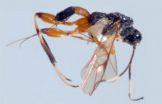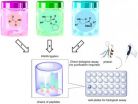(Press-News.org) For the first time, wasps in the genus Spasskia (family: Braconidae) have been found in China, according to an article in the open-access Journal of Insect Science. In addition, a species in that genus which is totally new to science was also discovered.
The new species, Spasskia brevicarinata, is very small — male and female adults are less than one centimeter long. It is similar to a previously described species called Spasskia indica, but the ridges on some of its body segments are different. In fact, the species epithet brevicarinata reflects a short ridge on its first tergite, as "brevi" is Latin for short and "carinata" is Latin for ridge.
High-quality photos of both species can be viewed at http://www.insectscience.org/14.119.
INFORMATION:
The Journal of Insect Science is an international, open access, peer-reviewed journal publishing papers in all aspects of the biology of insects and other arthropods from the molecular to the ecological, and their agricultural and medical impact.
It is published by the Entomological Society of America, the largest organization in the world serving the professional and scientific needs of entomologists and people in related disciplines. Founded in 1889, ESA today has nearly 7,000 members affiliated with educational institutions, health agencies, private industry, and government. Members are researchers, teachers, extension service personnel, administrators, marketing representatives, research technicians, consultants, students, and hobbyists. For more information, visit http://www.entsoc.org.
New parasitoid wasp species found in China
2014-09-08
ELSE PRESS RELEASES FROM THIS DATE:
Unusual immune cell needed to prevent oral thrush, Pitt researchers find
2014-09-08
PITTSBURGH, Sept. 8 – An unusual kind of immune cell in the tongue appears to play a pivotal role in the prevention of thrush, according to the researchers at the University of Pittsburgh School of Medicine who discovered them. The findings, published online today in the Journal of Experimental Medicine, might shed light on why people infected with HIV or who have other immune system impairments are more susceptible to the oral yeast infection.
Oral thrush is caused by an overgrowth of a normally present fungus called Candida albicans, which leads to painful white lesions ...
'Pick 'n' Mix' chemistry to grow cultures of bioactive molecules
2014-09-08
Chemists at ETH-Zürich and ITbM, Nagoya University have developed a new method to build large libraries of bioactive molecules – which can be used directly for biological assays – by simply mixing a small number of building blocks in water.
Zürich, Switzerland and Nagoya, Japan – Professor Jeffrey Bode of ETH-Zürich and the Institute of Transformative Bio-Molecules (ITbM) of Nagoya University, and his co-worker have established a new strategy called "synthetic fermentation" to rapidly synthesize a large number of bioactive molecules, which can be directly screened in ...
Trial shows improved overall survival for patients with liver cancer not amenable to surgery
2014-09-08
Singapore, 04 September 2014 – The mature results from a trial conducted by the Asia-Pacific Hepatocellular Carcinoma Trials Group led by the National Cancer Centre Singapore (NCCS) and Singapore General Hospital (SGH) have shown that patients who suffer from inoperable advanced hepatocellular carcinoma (HCC) may have a chance to live significantly longer by using a combined therapy.
The multi-centre phase II clinical trial was conducted at four Asia Pacific tertiary medical centres to evaluate the efficacy of combining two existing treatment modalities, Sorafenib and ...
New knowledge of cannabis paves the way for drug development
2014-09-08
Revolutionary nanotechnology method could help improve the development of new medicine and reduce costs. Researchers from the Nano-Science Center and the Department of Chemistry at the University of Copenhagen have developed a new screening method that makes it possible to study cell membrane proteins that bind drugs, such as cannabis and adrenaline, while reducing the consumption of precious samples by a billion times.
About 40% of all medicines used today work through the so-called "G protein-coupled receptors". These receptors react to changes in the cell environment, ...
Study examines discrimination among homeless adults in Toronto with mental illness
2014-09-08
TORONTO, Sept. 8, 2014—Vulnerable populations in ethnically diverse Toronto reported more discrimination by health care workers based on their housing status, mental health or substance abuse issues than race, a new study has found.
Forty-two per cent of people surveyed reported at least one form of perceived discrimination by health care workers, lead author Dr. Vicky Stergiopoulos wrote in a paper published today in the journal BMC Health Services Research.
The most prevalent form of perceived discrimination was due to mental illness or substance abuse (33 per cent) ...
Poor recording of physical health and medication could be causing dementia trials to fail
2014-09-08
Dementia trials could be failing because they all-too-often overlook the physical health of patients – according to new research from the University of East Anglia and Aston University.
More than 60 per cent of people with dementia are estimated to have three or more other conditions (co-morbidities).
The research shows how the combined effects of co-morbidities including diabetes, lung disease, arthritis and chronic heart failure are not being adequately described in dementia trials.
It investigates the extent of co-morbidities in people with dementia and the recording ...
Food craving is stronger, but controllable, for kids
2014-09-08
Children show stronger food craving than adolescents and adults, but they are also able to use a cognitive strategy that reduces craving, according to new research published in Psychological Science, a journal of the Association for Psychological Science.
"These findings are important because they suggest that we may have another tool in our toolbox to combat childhood obesity," says psychological scientist and lead researcher Jennifer A. Silvers, a post-doctoral fellow at Columbia University in the laboratory of Professor Kevin Ochsner.
Most interventions aimed at ...
Quick-cooled beers, perfect burgers and more: Chemistry Life Hacks, Vol. 3 (video)
2014-09-08
WASHINGTON, September 8, 2014 — It's the series that's one-part MacGyver, one-part Mendeleev. "Chemistry Life Hacks" is back with new tips that can change your life, or at least the temperature of your beer. Learn how to cool your brews quickly before the big game starts, get fruit flies out of your kitchen for good, and how to cook the perfect patty on the grill. Check out these tips and more at: http://youtu.be/QUE2O1276P8.
Subscribe to the series at Reactions YouTube, and follow us on Twitter @ACSreactions to be the first to see our latest videos.
INFORMATION:
The ...
Layered graphene sandwich for next generation electronics
2014-09-08
Writing in Nature Nanotechnology, the researchers have demonstrated how combining the two-dimensional materials in a stack could create perfect crystals capable of being used in next generation transistors.
Hexagonal boron nitride (hBN), otherwise known as white graphene, is one of a family of two-dimension materials discovered in the wake of the isolation of graphene at the University in 2004. Manchester researchers have previously demonstrated how combining 2D materials, in stacks called heterostructures, could lead to materials capable of being designed to meet industrial ...
Light detector to revolutionize night vision technology
2014-09-08
Researchers have developed a light detector that could revolutionise chemical sensing and night vision technology.
In the latest issue of Nature Nanotechnology, the team of researchers at Monash University, the University of Maryland in the US, and the US Naval Research Laboratory, have created the light detector based on graphene – a single sheet of interconnected carbon atoms.
The detector is capable of detecting light over an unusually broad range of wavelengths, included in this are terahertz waves – between infrared and microwave radiation, where sensitive light ...





